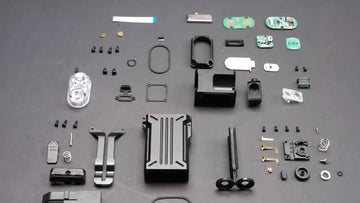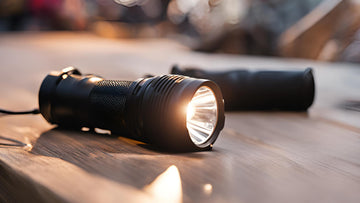Wuben Flashlight News
How Much Do You Know About Flashlight Light Sources? CRI and Color Temperature
Aug 09, 2024

If you’re into outdoor adventures, you probably already know a thing or two about picking the right flashlight.
You've likely got your checklist: it needs to be bright, lightweight, have a long battery life, and be tough enough to survive some bumps and splashes. Plus, who doesn’t love a flashlight with a bunch of brightness modes and easy USB charging?
Those are the basics, let’s chat about some lesser-known features that can make a difference, like CRI and color temperature. These might sound fancy, but they’re super important when you’re out in the wild.
What’s the deal with CRI?
CRI, or Color Rendering Index, is all about how well a light shows colors.Think of it like this: the sun has a CRI of 100, meaning it shows colors as they are. Other light sources get scored lower, depending on how close they come to the sun. A high CRI means you can see colors more accurately, which can be a big deal when you’re out there trying to spot things in nature.
Sure, brightness is key for seeing the big picture, but when you want to notice details—like telling if that berry is red or green—a good CRI is where it’s at. A flashlight with a CRI of 75 might need to be way brighter to show you the same details that one with a CRI of 90+ would.
Picture this: you’re shining a flashlight on some strawberries. With a high CRI light (say, CRI 95), those strawberries look juicy and vibrant. But with a lower CRI light (like CRI 75), they might look a bit dull and lifeless. Not as tasty, right?

Why High CRI Matters
So, why should you care about CRI? For starters, it can help you see things more clearly, which is pretty important when you’re outdoors.Imagine mistaking a venomous snake for a harmless stick because your light isn’t showing colors properly—not a situation you want to be in. High CRI lights give you a clearer, more accurate view of what’s around you, which can make all the difference in keeping you safe.
And if you’re into snapping photos of your adventures, a high CRI light is a must. It makes colors pop, giving you those Instagram-worthy shots of nature. That’s why companies like Wuben make sure some of their flashlights have high CRI options—because who doesn’t want the best of both worlds?
What About Color Temperature?
When we talk about color temperature, we’re talking about how “warm” or “cool” the light looks. Flashlights usually come in three flavors:- cool white (around 6500K)
- neutral white (around 4000K)
- warm white (less than 3000K)
LED flashlights create light by making a blue LED chip excite some phosphors, which then produce yellow light. The mix of blue and yellow gives you white light. Yellow light has a higher CRI, while blue is just a single wavelength. So, to get better color rendering, you crank up the yellow.
In general, warm light (lower color temperature) has better CRI, which makes it great for activities where seeing true colors matters. Plus, warm light has longer wavelengths, meaning it can cut through fog or mist better, helping you see more clearly when the weather’s not on your side. The downside? Warm LEDs can sometimes seem a bit dimmer and give everything a yellowish tint, like an old-school light bulb.

Neutral white is kind of the Goldilocks option—not too cool, not too warm. It strikes a good balance between showing colors accurately and being bright enough, which is why it’s a favorite for outdoor activities. You’ll see a lot of flashlights, including Wuben’s, rocking this color temperature.
The Lowdown on Colored Lights
Flashlights with colored lights—red, green, blue, and even UV—aren’t just for show. They each have their own special uses:- Red Light: Red light is easy on the eyes, meaning it helps preserve your night vision. It’s perfect for activities like stargazing or reading a map without blinding yourself or your buddies. It’s also good in foggy or wet conditions since it cuts through the haze better than white light.
- Blue Light: Blue Light’s got some cool tricks. It’s great for tracking blood trails when hunting or for spotting oil stains on machinery. It’s also popular in night fishing because it doesn’t spook the fish and makes certain things glow, like fishing floats or some types of bait.
- Green Light: Green light is super easy for our eyes to pick up on, so it looks brighter even if it’s not cranked up. This makes it ideal for reading maps or doing anything where you need to focus on fine details.
- UV Light: UV light has some niche uses, like spotting scorpions (yep, they glow under UV) or checking for counterfeit money. It’s not a daily need, but it’s cool to have if you’re into exploring the weird and wonderful.
And if you’re into photography, these colored lights can add some serious flair to your shots, especially when you’re playing around with light painting.
Not all flashlights are created equal. Whether you’re hitting the trail, capturing the beauty of the great outdoors, or just trying to see what’s in front of you, knowing the ins and outs of CRI, color temperature, and colored lights can make a difference.
So, next time you’re in the market for a new flashlight, don’t just go for the brightest option—think about what you need out there. A little knowledge can light up your path in more ways than one. Happy adventuring!
Related Articles



